
The rambutan is a medium-sized tropical tree in the family Sapindaceae. The name also refers to the edible fruit produced by this tree. The rambutan is native to Southeast Asia. It is closely related to several other edible tropical fruits including the lychee, longan, pulasan and mamoncillo.

Kalmia is a genus of about ten species of evergreen shrubs from 0.2–5 m tall, in the family Ericaceae. They are native to North America and Cuba. They grow in acidic soils, with different species in wet acid bog habitats and dry, sandy soils.

A perennial plant or simply perennial is a plant that lives more than two years. The term is often used to differentiate a plant from shorter-lived annuals and biennials. The term is also widely used to distinguish plants with little or no woody growth from trees and shrubs, which are also technically perennials.

Nephelium is a genus of about 25 species of flowering plants in the family Sapindaceae, native to southeastern Asia.
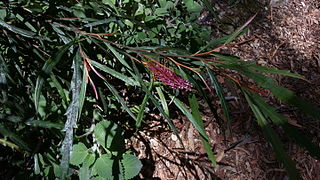
Grevillea longifolia, the fern-leaf spider flower, is a plant of the family Proteaceae, formerly known as Grevillea aspleniifolia. Commonly growing in the Sydney basin of central New South Wales, Australia Grevillea longifolia is recognizable by its deep red "toothbrush" flowers which appear in spring, and narrow, sawtoothed leaves. It is fairly readily grown in gardens.
Plants For A Future (PFAF) is an online not for profit resource for those interested in edible and useful plants, with a focus on temperate regions. The organization's emphasis is on perennial plants.
Nephelium chryseum is a species of plant related to the rambutan. The plant produces edible fruit that are covered in hard red shells with spikey spines. It is native to southern China, Borneo, the Philippines, and Vietnam.
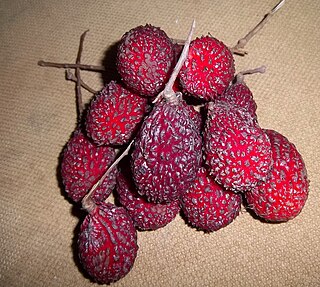
Nephelium xerospermoides, the hairless rambutan, is a species closely related to the rambutan. The drupe fruit has a flavor similar to rambutan. The fruit does not have any hair-like spines, hence its common name. They can be eaten freshly picked from the tree. They are not commonly grown or harvested for commercial use.

Pyracantha angustifolia is a species of shrub in the rose family known by the common names narrowleaf firethorn, slender firethorn and woolly firethorn. The flowers are white and produce small round pomes and can be orange to red in color. These fruits are astringent and bitter, making them inedible for humans, but they are a food source for birds. The leaves, fruit and seeds contain hydrogen cyanide, the source of the bitter taste. The stems and branches have sharp spines. This shrub is cultivated and grown in yards and gardens as an ornamental plant. It can be used to make hedges for home security. This species is native to China but has been introduced to North America and Australia. It is an invasive species in Hawaii and in other areas.
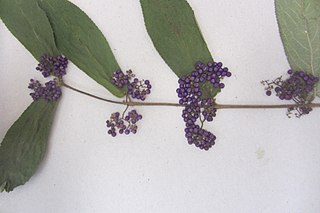
Callicarpa rubella is a species of beautyberry native to Southeast Asia. It is a shrub that produces pink or purple flowers followed by dark-purple berries. The berries are actually drupes. It is grown in gardens as an ornamental plant. The fruit attracts wildlife such as birds.
Pyracantha rogersiana, the Asian firethorn, is a species of flowering plant in the family Rosaceae, native to western China. Growing to 4 metres (13 ft) tall and broad, it is an evergreen shrub with glossy, narrow leaves, and masses of white flowers followed by small yellow berries 8 mm in diameter. It is grown in gardens, yards, and parks, where it can be used as hedging, wall cover, or in a mixed shrub border. The cultivar 'Flava' has gained the Royal Horticultural Society's Award of Garden Merit.

Sorbus vilmorinii, the Vilmorin's rowan or Vilmorin's mountain ash, is a species of flowering plant in the family Rosaceae, native to Sichuan, Tibet and Yunnan in China.
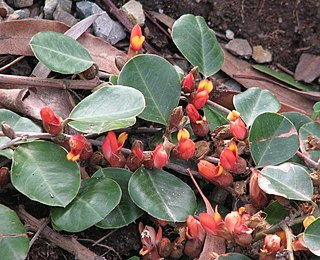
A prostrate shrub is a woody plant, most of the branches of which lie upon or just above the ground, rather than being held erect as are the branches of most trees and shrubs.

Passiflora maliformis, the sweet calabash, conch apple, wild purple passionfruit, or sweet cup, is a smallish (5cm) passionfruit with purple, yellow or green skin and a greyed-yellow to orange pulp that is aromatically-scented and -flavoured. It is a fast-growing vine, growing best in somewhat cooler-than-tropical climates. The rind is particularly hard and tougher than most passionfruits. It is usually eaten fresh or used to flavour drinks. It is a native to the Caribbean, Central America and Northern South America.

Conogethes punctiferalis, the durian fruit borer or yellow peach moth, is a moth of the family Crambidae.

Buddleja asiatica is a somewhat tender deciduous shrub native to a vast area of the East Indies, including India, Nepal, Bangladesh, China, Taiwan, Burma, Thailand, Laos, Cambodia, Vietnam, Malaysia, New Guinea, and the Philippines, growing in open woodland at elevations < 2,800 m either as understorey scrub, or as a small tree. First described by Loureiro in 1790, B. asiatica was introduced to the UK in 1874, and accorded the RHS Award of Garden Merit in 1993. It is highly invasive in Hawaii, Guam, and the Northern Mariana Islands.

Protea stokoei is a flowering shrub which belongs to the genus Protea. The plant is endemic to South Africa. It is found in the Kogelberg and Greenland mountains around Elgin.
Protea lacticolor or the Hottentot sugarbush, Hottentot white sugarbush or Hottentot’s Holland sugarbush, is a flowering shrub of the Protea genus. It is also known as the Hottentotwitsukkerbos. The plant is endemic to South Africa and is found from the Slanghoek to the Hottentots Holland Mountains and also the Groenlandberg.
Protea odorata is a small, sparsely branched, unisexual evergreen shrub that grows up to 1.5 metres tall. It has light green branches that turn brown with age and produce leaves that are upward or arched like leaves. The leaves are hairless and have a curved back and tips that can easily hurt the hand when touched. The leaves become black with age and the spines are pink or reddish in young years, but turn brown and brown with age.
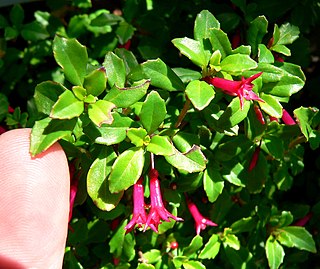
Fuchsia microphylla, also known as small leaf fuchsia and small-leaved fuchsia, is a flowering shrub in the family Onagraceae.














